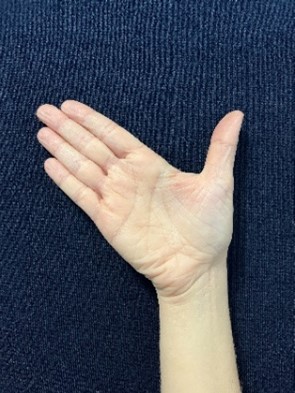Most wrist pain has a very simple cause and can settle with time. The pain may come from strained or inflamed soft tissues such as tendons and ligaments or the joints themselves.
You can often manage this pain yourself with over-the-counter medication, speak to your pharmacist (for advice).
There are several conditions that can cause pain in the hands and wrists including arthritis.
Should I see a medical professional?
Most cases of wrist pain will improve with time or self-help. However, you may need to see your doctor or physiotherapist if you experience the following.
Symptoms
You have tingling or loss of sensation in your hand or wrist and/or weakness.
- The pain is stopping you doing normal activities.
- The pain is getting worse or keeps coming back.
- If you have diabetes – hand problems are more common in people with diabetes.
- If you develop pain and increased swelling in the small joints with stiffness in the morning lasting more than 30 minutes to settle.
- Develop lumps or bumps that changed in shape or size.
If any of the below apply, then you should attend A&E
- You have severe pain.
- You have had recent or new trauma to your wrist.
- You suspect you have broken a bone or dislocated a joint.
- There was a snap, grinding or popping noise when you injured your hand.
- Your wrist has changed shape or colour.
- You cannot move your wrist, or hold things.
- You have suddenly got severe joint pain that is swollen red and hot.
What can I do to help my symptoms?
Activity modification
Avoiding the tasks that make the pain worse. Try to avoid tasks that are making or causing the pain to be worse. This may be repetitive in nature tasks such as opening a tin, painting or lifting heavy objects. You may have to change how you do some tasks to allow the wrist to get better.
Pain relief
Simple analgesia such as Paracetamol and an anti-inflammatory such as Ibuprofen can be very effective for the treatment of wrist pain. You can obtain advice regarding medication from your local pharmacist or GP but remember to read the packet; and do not take over the recommended dosage.
Topical anti-inflammatory products in the form of a cream or gel can also be used. These are applied directly to the specific area of pain and can help reduce pain and inflammation without the side effects of the anti-inflammatory tablets.
Anti-inflammatory gels can be especially helpful for individuals with arthritis. For further information you should discuss this option with your GP or pharmacist.
Ibuprofen is not recommended in the first 48 hours after an injury.
Cold or hot packs
A cold or hot pack can be helpful in offering symptomatic relief but must not be directly applied to the skin or to areas of skin that have poor sensation or are numb. A layer of protection (e.g. towel) should be used to cover the cold or hot pack so that it is not in direct contact with the skin.
Do not use ice or heat if you have circulatory problems, such as Raynaud’s disease, history of cold induced hypertension, peripheral vascular disease, allergy to cold (urticaria, joint pain) or sickle cell anaemia.
If your skin is usually numb over the injured area, please speak to your physiotherapist or GP before using a hot or cold pack / ice.
Ice must be used correctly otherwise ice burns can occur. Please see the instructions below:
- Start by wetting a cloth under a cold tap and then wring the cloth out until it is just damp.
- Place the damp cloth over affected area and then place either a plastic bag of crushed ice or a packet of frozen peas on top of the cloth. (The ice should be in small pieces in order to mould better to the area and help prevent ice burns).
- Leave the ice pack and cloth in place for approximately 10-15 minutes and repeat 3 to 4 times a day.
It is normal for your skin to go slightly red or pink. Remove the ice if extreme redness/pain, blistering or an increase in swelling occurs. If this does occur, please call NHS Direct for further advice.
If your hands are painful and stiff, heat packs, hot water bottles, or filling up the sink with warm water and moving your hand and wrist can be really soothing.
Do not apply heat to a swollen or recently injured hand or wrist.
Rest
Try to rest the hand and wrist for the first 24-72 hours after an injury. However, it is important to maintain flexibility in the wrist so you can gently move it without causing too much pain. This will ensure your wrist does not become too stiff and it will help the healing process.
Wearing a splint
Wearing a splint to support your wrist and ease pain for certain functional tasks. You can get these at most pharmacies and supermarkets. However, it is important that splints are not used continuously as wearing a splint too much can end up causing you to have increased stiffness and weakness at the wrist.
Exercises
Completing some gentle exercises helps to maintain the movement in your joints.
If any of these exercises on the next page make your symptoms worse do not complete them.
Aim to complete 5 to 10 repetitions of each exercise, 3 x day.
Hand exercises





Thumb exercises


Wrist exercises




What about work?
Maintaining all normal activities including work improves your chance of recovery by keeping you moving. This helps you keep your ‘work fitness’ and prevents your wrist getting weak, which can prolong your pain.
You do not have to be pain free to return to or remain at work.
It may be necessary to do temporary lighter or modified duties. This should be discussed with your line manager initially. If further clarification is needed your Occupational Health advisor can identify more specific role modifications.
What should I do if I am still experiencing problems?
If you are unable to agree on restricted roles with you manager or you are still having problems (despite following this advice): your occupational health team can help. The occupational health team can advise you on how to bridge the gap to help you return to normal activities.
You can also gain access to the occupational health physiotherapy team.
Self-referral portal
Staff can self-refer into Newcastle Occupational Health Service by completing an online self-referral.
The online referral portal will replace the downloadable self-referral forms that staff have previously completed and emailed across to the service.
Find out more and for further help in completing a self-referral.
Management referral
Management referrals will be completed and processed using an online system which we will be launching soon.
We will be contacting managers shortly in order to onboard them onto the system.